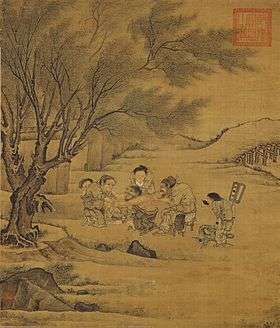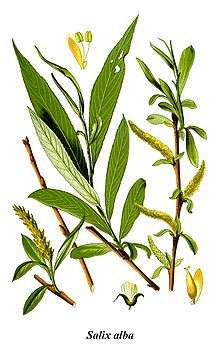Moxibustion
| Moxibustion | |
|---|---|
| Intervention | |
 Moxibustion by Li Tang, Song dynasty | |
| MeSH | D009071 |





Moxibustion (Chinese: 灸; pinyin: jiǔ) is a traditional Chinese medicine therapy which consists of burning dried mugwort (moxa) on particular points on the body. It plays an important role in the traditional medical systems of China (including Tibet), Japan, Korea, Vietnam, and Mongolia. Suppliers usually age the mugwort and grind it up to a fluff; practitioners burn the fluff or process it further into a cigar-shaped stick. They can use it indirectly, with acupuncture needles, or burn it on the patient's skin.
Terminology
The first Western remarks on moxibustion can be found in letters and reports written by Portuguese missionaries in 16th-century Japan. They called it “botão de fogo” (fire button), a term originally used for round-headed Western cautery irons. Hermann Buschoff, who published the first Western book on this matter in 1674 (English edition 1676), used the Japanese word mogusa. As the u is not very strongly enunciated, he spelled it “Moxa”. Later authors blended “Moxa” with the Latin word combustio (burning).[1][2]
The name of the herb Artemisia (mugwort) species used to produce Moxa is yomogi (蓬) in Japan and ài or àicǎo (艾, 艾草) in Chinese.[3]
The Chinese names for moxibustion are jiǔ ( 灸) or jiǔshù ( 灸術); Japanese use the same characters and pronounce them as kyū and kyūjutsu. In Korean the reading is tteum (뜸). Korean folklore attributes the development of moxibustion to the legendary emperor Dangun.[4]
Theory and practice
Practitioners use moxa to warm regions and meridian points[5] with the intention of stimulating circulation through the points and inducing a smoother flow of blood and qi. Some believe it can treat conditions associated with the "cold" or "yang deficiencies" in Chinese Medicine.[6] It is claimed that moxibustion mitigates against cold and dampness in the body, and can serve to turn breech babies.[7][8]
Practitioners claim moxibustion to be especially effective in the treatment of chronic problems, "deficient conditions" (weakness), and gerontology. Bian Que (fl. circa 500 BCE), one of the most famous semi-legendary doctors of Chinese antiquity and the first specialist in moxibustion, discussed the benefits of moxa over acupuncture in his classic work Bian Que Neijing. He asserted that moxa could add new energy to the body and could treat both excess and deficient conditions.
Practitioners may use acupuncture needles made of various materials in combination with moxa, depending on the direction of qi flow they wish to stimulate.
There are several methods of moxibustion. Three of them are direct scarring, direct non-scarring, and indirect moxibustion. Direct scarring moxibustion places a small cone of moxa on the skin at an acupuncture point and burns it until the skin blisters, which then scars after it heals.[9] Direct non-scarring moxibustion removes the burning moxa before the skin burns enough to scar, unless the burning moxa is left on the skin too long.[9] Indirect moxibustion holds a cigar made of moxa near the acupuncture point to heat the skin, or holds it on an acupuncture needle inserted in the skin to heat the needle.[9] There is also stick-on moxa.
Medical research
The first modern scientific publication on moxibustion was written by the Japanese physician Hara Shimetarō who conducted intensive research about the hematological effects of moxibustion in 1927. Two years later his doctoral dissertation on that matter was accepted by the Medical Faculty of the Kyūshū Imperial University.[10] Hara's last publication appeared in 1981.[11]
A Cochrane Review found limited evidence for the use of moxibustion in correcting breech presentation of babies, and called for more experimental trials.[12] Moxibustion has also been studied for the treatment of pain,[13] cancer,[14] stroke,[15] ulcerative colitis,[16] constipation,[17] and hypertension.[18] Systematic reviews have found that these studies are of low quality and positive findings could be due to publication bias.[19]
Parallel uses of mugwort
Mugwort amongst other herbs was often bound into smudge sticks. The Chumash people from southern California have a similar ritual.[20] Europeans placed sprigs of mugwort under pillows to provoke dreams; and the herb had associations with the practice of magic in Anglo-Saxon times.
See also
References
- ↑ Wolfgang Michel (2005). "Far Eastern Medicine in Seventeenth and Early Eighteenth Century Germany". Gengo bunka ronkyū 言語文化論究. Kyushu University, Faculty of Languages and Cultures. 20: 67–82. ISSN 1341-0032.
- ↑ Li Zhaoguo (2013). English Translation of Traditional Chinese Medicine: Theory and Practice. 上海三联书店. p. 11. ISBN 978-7-5426-4084-0.
- ↑ There is a great variety of further Chinese names (bingtai 冰台、ecao 遏草、xiang'ai 香艾、qiai 蕲艾、aihao 艾蒿、jiucao 灸草﹑yicao 医草﹑huangcao 黄草﹑airong 艾绒)
- ↑ Needham, J; Lu GD (2002). Celestial lancets: a history and rationale of acupuncture and moxa. Routledge. pp. 262. ISBN 0-7007-1458-8.
- ↑ Not all acupuncture points can be used for moxibustion. A few of them are preferred in both classical literature and modern research: Zusanli (ST-36), Dazhui (GV-14).
- ↑ https://www.yinovacenter.com/chinese-medicine/moxibustion/[]
- ↑ American Journal of Chinese Medicine, Winter, 2001, Yoichi Kanakura, et al.
- ↑ Cochrane Library
- 1 2 3 "Moxibustion, Acupuncture Today". Acupuncturetoday.com. Retrieved 2011-05-17.
- ↑ English summary of S. Hara’s findings Archived 14 July 2014 at the Wayback Machine.
- ↑ Watanabe, Shinichiro; Hakata, Hiroshi; Matsuo, Takashi; Hara, Hiroshi; Hara, Shimetaro (1981). "Effects of Electronic Moxibustion on Immune Response I". Zen Nihon Shinkyu Gakkai zasshi. 31 (1): 42–50. doi:10.3777/jjsam.31.42.
- ↑ Coyle, M. E.; Smith, C. A.; Peat, B (2012). "Cephalic version by moxibustion for breech presentation". Cochrane Database of Systematic Reviews. 5 (5): CD003928. doi:10.1002/14651858.CD003928.pub3. PMID 22592693.
- ↑ Lee, Myeong Soo; Choi, Tae-Young; Kang, Jung Won; Lee, Beom-Joon; Ernst, Edzard (2010). "Moxibustion for Treating Pain: A Systematic Review". The American Journal of Chinese Medicine. 38 (5): 829. doi:10.1142/S0192415X10008275. PMID 20821815.
- ↑ Lee, Myeong Soo; Choi, Tae-Young; Park, Ji-Eun; Lee, Song-Shil; Ernst, Edzard (2010). "Moxibustion for cancer care: A systematic review and meta-analysis". BMC Cancer. 10: 130. doi:10.1186/1471-2407-10-130. PMC 2873382
 . PMID 20374659.
. PMID 20374659. - ↑ Lee, M. S.; Shin, B.-C.; Kim, J.-I.; Han, C.-h.; Ernst, E. (2010). "Moxibustion for Stroke Rehabilitation: Systematic Review". Stroke. 41 (4): 817. doi:10.1161/STROKEAHA.109.566851. PMID 20150551.
- ↑ Lee, Dong-Hyo; Kim, Jong-In; Lee, Myeong Soo; Choi, Tae-Young; Choi, Sun-Mi; Ernst, Edzard (2010). "Moxibustion for ulcerative colitis: A systematic review and meta-analysis". BMC Gastroenterology. 10: 36. doi:10.1186/1471-230X-10-36. PMC 2864201
 . PMID 20374658.
. PMID 20374658. - ↑ Lee, Myeong Soo; Choi, Tae-Young; Park, Ji-Eun; Ernst, Edzard (2010). "Effects of moxibustion for constipation treatment: A systematic review of randomized controlled trials". Chinese Medicine. 5: 28. doi:10.1186/1749-8546-5-28. PMC 2922210
 . PMID 20687948.
. PMID 20687948. - ↑ Kim, Jong-In; Choi, Jun-Yong; Lee, Hyangsook; Lee, Myeong Soo; Ernst, Edzard (2010). "Moxibustion for hypertension: A systematic review". BMC Cardiovascular Disorders. 10: 33. doi:10.1186/1471-2261-10-33. PMC 2912786
 . PMID 20602794.
. PMID 20602794. - ↑ Lee, Myeong Soo; Kang, Jung Won; Ernst, Edzard (2010). "Does moxibustion work? An overview of systematic reviews". BMC Research Notes. 3: 284. doi:10.1186/1756-0500-3-284. PMC 2987875
 . PMID 21054851.
. PMID 21054851. - ↑ Timbrook, Janice (2007). Chumash Ethnobotany: Plant Knowledge among the Chumash People of Southern California. ISBN 978-1-59714-048-5.
External links
| Wikimedia Commons has media related to Moxibustion. |
| Look up moxibustion in Wiktionary, the free dictionary. |
- W Michel: Far Eastern Medicine in Seventeenth and Early Eighteenth Century Germany
- Hermann Buschoff, The gout, more narrowly searcht, and found out; together with the certain cure thereof. London 1676. W Michel ed. Fukuoka, March 2003. (Japanese introduction by the editor, English text)
